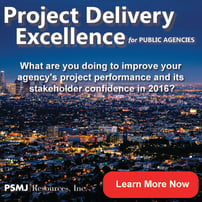 In my lengthy career of delivering infrastructure projects, I have both witnessed, and been part of a slow evolution of project thought from solving a particular problem to solving a particular problem while concurrently enhancing the community.
In my lengthy career of delivering infrastructure projects, I have both witnessed, and been part of a slow evolution of project thought from solving a particular problem to solving a particular problem while concurrently enhancing the community.
I took over the local flood control district during a period of turmoil, and quickly found that people in the communities where our facilities were constructed did not like them.
My predecessor was a great engineer who could design and build a flood channel that would be inexpensive to build and operate and minimize right-of-way take. He was constructing concrete channels all over Phoenix and the surrounding communities.
But these channels would be ugly; they would separate neighborhoods, and also be where old shopping carts went to die. I started an initiative to create a “kinder, gentler flood control district.” We hired a landscape architect, and placed him and an assistant into the midst of our design group.
We held seminars to teach engineers how to soften their technical approach. We began to integrate public amenities into our flood projects. For example, we constructed soccer fields in the bottom of a retention basin; we constructed a skateboard park in another basin, created ball fields, and landscaped open space all while accomplishing the primary purpose of flood control and storm water management.
OK, that’s history. Where are we headed now?
As I work with public infrastructure delivery agencies today, I am finding that the trend is definitely towards more integrated projects. More landscaping, more “context sensitive” design, more integration of ancillary projects into the project. For example, a roadway improvement may now have bicycle lanes or even (out here in Arizona) a
horse trail.
I am seeing an accelerating trend away from adding traffic lanes, even though warrants are met, to “road diets” where transportation agencies are deliberately removing traffic lanes to discourage traffic, particularly single-user automobiles, thus protecting pedestrians and sensitive communities from the noise and pollution of automobiles.
The other trend is that the Millennial generation is far less enamored with cars and driving than, certainly, my generation was. Many of the Millennials in the mid-to-late 20s still don’t drive. Many prefer to live in cities that use public transportation and are “walking cities” (such as Boston).
What this means is that we need to adjust to this emerging mindset. We need to work comfortably in multi-specialized teams, integrating non-engineering specialties into the design process. For example, instead of giving a set of nearly complete roadway plans to a landscape architect and instructing her to “sprinkle plants all over the place,” we must include them in the outset, taking the architect’s advice on location, alignment, and other matters. We need to include social scientists, urban planners, and other non-technical specialties and heed their counsel. Integrated design teams will be the wave of the future.
About the Author: Michael Ellegood, P.E., has over 40 years of project delivery experience both as a private consultant and as a county engineer/public works director. He is a Senior Consultant with PSMJ Resources and a frequent contributor to the PSMJ newsletter. Contact him at mellegood@psmj.com.
 Interested in more public works project management best practices? PSMJ's Project Delivery Excellence For Public Agencies focuses on simple project management approaches that achieve better results than traditional, less-effective, more time-consuming methods. This program will provide you with the tools to more efficiently manage multiple projects while controlling the schedule and budget and the changes that inevitably happen. Our project management protocols focus exclusively on
Interested in more public works project management best practices? PSMJ's Project Delivery Excellence For Public Agencies focuses on simple project management approaches that achieve better results than traditional, less-effective, more time-consuming methods. This program will provide you with the tools to more efficiently manage multiple projects while controlling the schedule and budget and the changes that inevitably happen. Our project management protocols focus exclusively on the public works environment and issues that specifically hit the public sector on a daily basis.
You also might be interested in these related blog posts:
4 Essential Project Management Tips for A/E Professionals
How to Overcome Impediments to Effective Project Management
Project Change Management – How Other Industries Do It
Today's Top Ten Project Management Trends
Transportation Project Management


